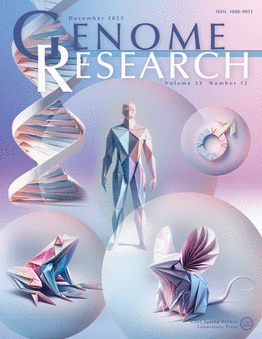从序列中预测替代剪接和剪接改变突变的参考信息
IF 6.2
2区 生物学
Q1 BIOCHEMISTRY & MOLECULAR BIOLOGY
引用次数: 0
摘要
在高等真核生物中,替代剪接在蛋白质多样性和基因表达调控中起着至关重要的作用,而导致剪接失调的突变是一系列遗传疾病的根源。通过计算预测基因组序列中的替代剪接,不仅可以深入了解基因调控机制,还有助于确定致病突变和药物靶点。然而,目前对剪接位点使用情况进行定量预测的方法准确性仍然有限。在此,我们介绍一种深度神经网络模型 DeltaSplice,该模型经过优化,可从同源基因的比较分析中学习突变对替代剪接定量变化的影响。该模型的结构使DeltaSplice能够执行 "参考信息预测",即结合参考基因序列的已知剪接位点使用情况来改进其对剪接改变突变的预测。我们在各种预测任务上对 DeltaSplice 和其他几种最先进的方法进行了基准测试,包括人类群体和神经发育疾病中特定剪接和剪接改变突变的进化序列分歧,结果表明 DeltaSplice 的表现始终优于其他几种方法。DeltaSplice 预测了人脑中约 15% 的剪接定量性状位点 (sQTL),作为剪接改变变异的因果关系。它还预测了自闭症和其他神经发育障碍(NDD)患者子集中剪接位点外的剪接改变变异,其中包括 19 个具有复发性剪接改变变异的基因。将剪接改变突变与其他类型的非原发突变负担相结合,可以预测出 8 个新的 NDD 风险基因。我们的工作拓展了剪接硅学模型的能力,有望应用于基因诊断和基于剪接的精准医疗的开发。本文章由计算机程序翻译,如有差异,请以英文原文为准。
Reference-informed prediction of alternative splicing and splicing-altering mutations from sequences
Alternative splicing plays a crucial role in protein diversity and gene expression regulation in higher eukaryotes and mutations causing dysregulated splicing underlie a range of genetic diseases. Computational prediction of alternative splicing from genomic sequences not only provides insight into gene-regulatory mechanisms but also helps identify disease-causing mutations and drug targets. However, the current methods for the quantitative prediction of splice site usage still have limited accuracy. Here, we present DeltaSplice, a deep neural network model optimized to learn the impact of mutations on quantitative changes in alternative splicing from the comparative analysis of homologous genes. The model architecture enables DeltaSplice to perform "reference-informed prediction" by incorporating the known splice site usage of a reference gene sequence to improve its prediction on splicing-altering mutations. We benchmarked DeltaSplice and several other state-of-the-art methods on various prediction tasks, including evolutionary sequence divergence on lineage-specific splicing and splicing-altering mutations in human populations and neurodevelopmental disorders, and demonstrated that DeltaSplice outperformed consistently. DeltaSplice predicted ~15% of splicing quantitative trait loci (sQTLs) in the human brain as causal splicing-altering variants. It also predicted splicing-altering de novo mutations outside the splice sites in a subset of patients affected by autism and other neurodevelopmental disorders (NDD), including 19 genes with recurrent splicing-altering mutations. Integration of splicing-altering mutations with other types of denovo mutation burdens allowed prediction of eight novel NDD-risk genes. Our work expanded the capacity of in silico splicing models with potential applications in genetic diagnosis and the development of splicing-based precision medicine.
求助全文
通过发布文献求助,成功后即可免费获取论文全文。
去求助
来源期刊

Genome research
生物-生化与分子生物学
CiteScore
12.40
自引率
1.40%
发文量
140
审稿时长
6 months
期刊介绍:
Launched in 1995, Genome Research is an international, continuously published, peer-reviewed journal that focuses on research that provides novel insights into the genome biology of all organisms, including advances in genomic medicine.
Among the topics considered by the journal are genome structure and function, comparative genomics, molecular evolution, genome-scale quantitative and population genetics, proteomics, epigenomics, and systems biology. The journal also features exciting gene discoveries and reports of cutting-edge computational biology and high-throughput methodologies.
New data in these areas are published as research papers, or methods and resource reports that provide novel information on technologies or tools that will be of interest to a broad readership. Complete data sets are presented electronically on the journal''s web site where appropriate. The journal also provides Reviews, Perspectives, and Insight/Outlook articles, which present commentary on the latest advances published both here and elsewhere, placing such progress in its broader biological context.
 求助内容:
求助内容: 应助结果提醒方式:
应助结果提醒方式:


